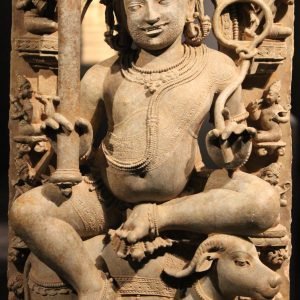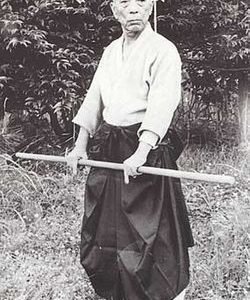吾れ々々お互が、死と云うものを考えた時、どんな感じがするか、何だか飽気無い、寂しい感じがする。それは死後の考え方によるものである。
Individually, when each one of us thinks about death, how do we feel? Somehow tireless and lonely. It is a post-mortem concept.
死という永遠の旅から帰って来た人の物語りを聞いた実例も無いから、当然淋しさを感ぜられるのが人間の心情である。
Because there is no actual example of hearing the story of a person who has returned from the eternal journey of death, the natural human emotion to this is loneliness.
末開人霊魂観を始め、素朴なものには、この死という考えが色々と判断せられ、墓場から人魂が飛んだり、干蘭盆の節に情霊が還って来たりする考え方は、この類である。
Starting with the view of the human soul of primitive people, to put it simply, there are various ideas of death, like the concept of thinking that the human soul flies away from the graveyard or that a spirit returns at the time of the Feast of Lanterns, This type of thinking.
灯篭流しという夏の美しい行事も、この思想に関連している。神道の霊魂観は、大体この線に沿っている。
The beautiful summer event of Tōrōnagashi or “floating lanterns on the water” is also related to this idea. Shinto’s view of the soul generally follows this line.
死によって幽明境を異にした霊魂は、幽界に存在しつづける。明界(現界のこと)に生きている人間の眼には、この存在は全く見えない。しかし幽界から人間の世界は、あり々々と見えるというような考え方が普通に行われている。
Depending on the death, the soul that has gone to heaven, continues to exist in the world of ghosts. This existence is completely invisible to the eyes of humans living in the real world. However, it is common to think that the human world can be seen from the ghost world.
の思想は、かような霊魂観と類似点を持ちながら、しかし異った類型に属するものである。同じ一つの生命が様々な生物の肉体を借りて幾度も繰り返えして、この地上の生活を営む。
The idea of the reincarnation of the soul, while having similarities with such a view of the soul, do belong to different types. The same single life borrows the body of various creatures and repeats the cycle many times to live this earthly life.
すなわち人間は、死後なおこの地上で生き代り、死に代りするというのである。
In other words, humans, after death are to be born again on this earth, in place of a death.
輪廻観は、この地上の生活が結局苦であるという印度的厭世思想を基低としている。輪廻の生は、全体として苦なるが故に、人間の最終の理想は、この輪廻の連鎖から脱することである。
The concept of reincarnation is based on the pessimistic Indian idea that life on the earth is suffering until the end. Since life after reincarnation is suffering as a whole, the ultimate ideal for human beings is to break out of this cycle or chain of reincarnation.
それ故輪廻の生は、永遠の生命として、人々の希求の的になるような性質のものではない。しかし、それにも拘らず通俗の信仞仰としては輪廻の生を重ね得るということが、死に直面した人々の生への執着に対する安全弁となっている。
Therefore, reincarnation, as eternal life, is not a life of the nature that people seek. But, nevertheless, as a popular religion, the idea that life can be repeated through reincarnation is a safety valve against attachment for those that are facing death.
このことは見逃がせないが、死後の生命の永存問題として、最顕著な展開を示したのは、様々な理想世界・末来国の信仰であるユダヤ教やキリスト教の天国・地獄思想がそれである。
This cannot be overlooked, but as the eternal question of life after death, the most notable development was the various ideal worlds. The heaven and hell of Judaism and Christianity are such worlds.
後には煉獄の思想も現れて来る。仏教の西方極楽浄士の思想の如きは、それである。
Later, the idea of purgatory will also appear. Such is the thought of “saihogokurakujodo” or Amidanyorai’s pure land (阿弥陀如来浄土).
ここでは唯単に、生命が存続しているという事だけではない。地上では報いられざる生活に沈淪し、悲惨なる死を遂げた人も、その心の持ち方が正しく、信仰が篤ければ、あの世においては、幸福な永遠の生命が約束される。
Here simply speaking, life is not just about being alive. While on earth, to live a life or relentless non-reward, even those who die a dire death, if the way they held their heart was correct, if their faith was strong, a happy and eternal life is promised.
悪にして富み栄え、この世を奔弄し尽したかと思われる者には、怖ろしい地獄の焰が待っている。
For those who are prosperous through evil and for those who seem to have taken the world by storm, the scary flames of hell are waiting.
いづれにしても死後の世界・未来の国についての観念は、宗教的理想が昂まるにつれて、次第に洗練されて来る。それは、人間の小さな善悪や恩讐を離れた崇高な愛や慈悲に満ちた絶対の理想世界として描かれて来る。
In any case, the notion of an afterlife or a “kingdom come”, become increasingly sophisticated as religious ideals were gradually refined. It is portrayed as an absolute ideal world full of sublime love and mercy away from petty human evil and vengeance.
かような世界に、やがては生まれ得るという信仰が、地上の生活を高めることになるのである。かくて死を超えた大きな拡がりをもった死生観が生まれてくると、死の意味が変わってくる。
In such a world, the belief that we could be born eventually, would enhance life here on earth. Thus, a new view of life and death is born that is beyond death, and then the meaning of death changes.
死は肉体的な命の終わりであっても、その後には無限の霊的生命がつづいている。生命は単なる終わりではない。親しき者の死も永遠の別離ではない。やがて彼の世で期すべき再会の日までの暫しの別れに過ぎない。
Death is the end of the physical life, after that infinite spiritual life follows. Life does not simply end. The death of someone close is not eternal separation. It is only a short break until the day of the expected reunion.
死は、いわば生命の在り方の一つの切り替えを意味する。すなわち新しき門出の日というに過ぎない。と同時に地上において、お互が親となり、子となる縁にして、元より相知り、相見る者は死後天国においても、離るべからずして撃る縁の者である。
Death, in a sense, is one switch or change in the way of life. Death, in a sense, is one switch or change in the way of life. In other words, it’s just a new day. At the same time, on earth, each will become children and parents, and they will know each other from the beginning.
然るに何ぞや。相憎み、相啀み合うことの愚かさよ。ここに天津蹈鞴秘文に、
Anyway, hatred and hostility are a foolish pair. Here in the Amatsu Tatara Hibun it states,
身をつくす 甲斐はなくとも
誠もてつくしおくこそ 人の道なれ
Dedicate yourself completely, Even if it’s not worth it
And to pursue sincerity, the way of mankind.
と詠まれてある如く、人間は相親しみ、相愛しみ、相助け合うことが自然の人道である。
As it is written, human beings are friendly, affectionate, and help each other. It is the natural path on mankind.
天津蹈鞴神籬遍という訓は、自然・天地の大道にして、神の籬とは恵みが垂るる。すなわち神の恵みが垂れて、草木花実に至るまで繁茂するという訓である。
The philosophy of the Amatsu Tatara Hiromogi-hen is that understanding nature and the order of heaven and earth is the great path to receiving god’s grace. In other words, the grace of god falls upon us all and the lesson is that it’s grace even makes the plants and fruits thrive.
故に神随らの恵みと共に、人も互に相愛しみ、相救け合うように、そのために神随らの恵みの力を説かれた秘文である。
Therefore, with the blessings of god, people love each other, help each other. It is a secret document that preaches the power of the grace of god.
昭和二十三年四月三日 高松澄水
April 3, 1948 Takamatsu Chōsui
(Translated by Sean Askew, February 22nd, 2020)















